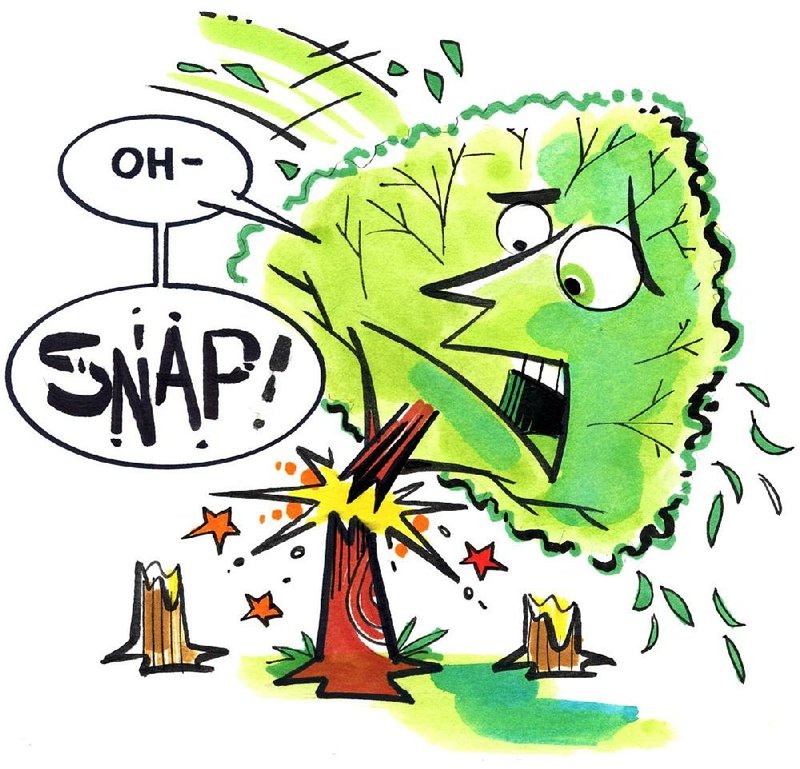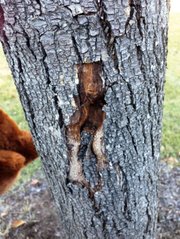First, a correction. In my Jan. 2 column about Swiss chard, I put it in the wrong family. It is not a member of the cole crops but rather in the amaranth family, which includes spinach, beets and quinoa. It formerly was in the goosefoot family or Chenopodiacea, but has since been moved to the amaranth family. If you have Swiss chard or beets planted near cabbage or broccoli, the cabbage worms usually won't eat the leaves of Swiss chard, since they aren't in the same family. Sorry for the mistake.
Q I have attached two pictures of damage to a Bradford pear tree. It was not physically hit. Is it a disease or insect problem, and what can I do to fix it? The tree is only 2 years old.
A Your tree was wounded at some point, possibly even damaged from the limbs spreading above the point of the wound. If you look at the bark beneath the wound, you can tell there is damage there as well, and the bark will eventually slough off. Bradford pear trees grow quite quickly and are top-heavy. This makes them susceptible to easy damage during storms. We see a lot of split trunks or tops broken out. With your tree, you now have internal decay at the point of the wound, which will make the tree even more susceptible to damage. Once decay begins, there is little you can do to stop the spread. Keeping the area cleaned out will help a bit, but as young as this tree is, it might be a better idea to plant a new tree to take its place -- preferably something other than a blooming pear.
Q My azaleas have a lot of yellow leaves on them. What is wrong with them, and what do I need to do to them?
A Take a close look at your shrubs. If the yellow leaves are primarily toward the base of the branches, then it is simply old leaves shedding. The younger leaves and flower buds are those closer to the tops of the branches, and they should be healthy and green. Evergreen shrubs shed old leaves from time to time, and some varieties of azaleas and gardenias tend to do a leaf shed all at once. White and light pink varieties of azaleas' leaves turn yellow before they fall, while leaves on the darker-blooming varieties typically turn a dark reddish color before they shed. Normally we see this happening in the fall, but the mild weather we had in December has a lot of plants confused. If that is what you have, there's no need to worry. However, if all the leaves are turning yellow, then we have a problem. Wet feet can be an issue -- plants are not growing as much in cool weather, and don't use as much water. They also lose less water to evaporation when it is cool, and we have had a lot of rain, so check the drainage. If the veins are green and the leaves are yellow, the pH of the soil is too high. If azaleas don't have acidic soil conditions, they develop iron chlorosis. They can't pull the right nutrients from the soil in high pH soils. If you see this symptom, have your soil tested to see what its pH is, and correct it if needed.
Q A friend gave me some plants and told me they were Louisiana water irises. In a public place, I saw the same exact plants with the same exact flowers, but the identifying plate said they were "Southern Blue Flag Irises." The Southern Blue Flags bloomed in the spring but they also bloomed in November-December. My irises only bloomed in the spring. Are these the same irises? And could the Southern Blue Flags be a hybrid, because they did bloom again in the autumn? I think they bloomed that late because it has been so warm.
A There are a lot of different types of irises out there and iris growers are constantly coming up with new hybrids. Most fall into the bearded or nonbearded type. Louisiana irises are native to the American Gulf Coast and are nonbearded; they require soil that is somewhat acidic and wet in the spring. The blooms are usually very wide petaled and open, showing brightly colored style arms and sharp signal crests. They come in a wide array of colors, including blue, but also reds, pinks, whites, etc. They are not the only nonbearded, water-loving irises: Japanese irises are typically the last of the irises to bloom in summer, and they require a slightly acidic soil. Blooms are usually huge, ruffled and flat in form; some are marbled with gray or white. "Flag" is a common name given to many types of iris. And while there is another whole host of reblooming irises, I think many plants were confused this December with the mild weather. I saw numerous irises blooming, along with some daylilies, azaleas and other spring bloomers. Winter appears to be with us now, so maybe plants will go back into dormancy.
Q Will my azaleas still bloom this spring since they bloomed in December?
A I think a lot depends on what the rest of the winter holds in store. While many spring-blooming plants did have some blooms (and still do), they were not in full bloom. There are still branches with flower buds. But many plants have started putting on new growth and that could get zapped in really cold weather. Time will tell. Don't prune or do anything else to the plants. Just wait for spring and hope for the best.
Janet B. Carson is a horticulture specialist for the University of Arkansas Cooperative Extension Service. Write to her at 2301 S. University Ave., Little Rock, Ark. 72204 or email her at
jcarson@arkansasonline.com
HomeStyle on 01/09/2016

